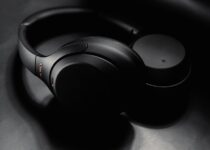Difference between on-ear and over-ear headphones
Are you in the market for a new pair of headphones, but not sure which style to choose? On-ear or over-ear headphones are two popular options, each with its own unique benefits.
In this article, we’ll explore the key differences between these two styles, so you can make an informed decision.
In short, on-ear headphones rest on the outer part of your ears, while over-ear headphones fully enclose your ears. This difference in design can impact comfort, sound quality, and noise isolation.
But which style is right for you? To answer that, we’ll dive deeper into the pros and cons of each style, and provide expert insights from audio professionals and enthusiasts.
So, whether you’re a music lover, a gamer, or simply looking for a comfortable way to tune out distractions, read on to discover the differences between on-ear and over-ear headphones, and find the perfect pair for your needs.
Are On-Ear or Over-Ear Headphones Better? Understanding the Differences
If you’re in the market for new headphones, you may be wondering whether to choose on-ear or over-ear headphones.

Both styles have their own unique benefits, but which one is right for you?
Understanding these differences can help you choose the right style for your needs.
In this article, we’ll explore the key differences between on-ear and over-ear headphones, so you can make an informed decision.
What Are On-Ear Headphones?
On-ear headphones, as the name suggests, rest on the outer part of your ears. They typically have a smaller earcup than over-ear headphones, and the headband usually sits on the top of your head.
On-ear headphones are often more compact and portable than over-ear headphones.
What Are Over-Ear Headphones?
Over-ear headphones, also known as circumaural headphones, fully enclose your ears with larger ear cups. The headband usually rests on the top of your head, providing a more secure fit.
Over-ear headphones are known for their superior sound quality and noise isolation.
Comfort
When it comes to comfort, both on-ear and over-ear headphones have their pros and cons. On-ear headphones are generally lighter and less bulky than over-ear headphones, making them more comfortable for extended wear.
However, the pressure of the earcups on your ears can cause discomfort or even pain after a while.
Over-ear headphones are heavier and bulkier, but they distribute the weight more evenly across your head, reducing pressure on your ears.
Sound Quality
Sound quality is a major consideration when choosing headphones. Over-ear headphones are generally regarded as superior in this regard, due to their larger drivers and enclosed design.
The larger earcups provide more space for the drivers to work, resulting in a fuller, more detailed sound.
On-ear headphones, on the other hand, are more susceptible to outside noise and may not provide as much bass or overall volume.
Noise Isolation
If you’re looking to block out external noise, over-ear headphones are the way to go. Their closed-back design effectively blocks out ambient noise, allowing you to focus on your music or other audio.
On-ear headphones, however, typically have an open-back design that allows some external noise to leak in.
Portability
If you’re planning to use your headphones on the go, portability is a major consideration. On-ear headphones are generally more compact and lightweight, making them easier to carry around.
However, over-ear headphones often have a foldable design that makes them more compact when not in use.
Durability
Durability is important when investing in a pair of headphones, as you want them to last as long as possible.
While both styles can be durable, over-ear headphones tend to be more robust due to their larger size and construction.

The ear cups of over-ear headphones are typically padded with thicker and more durable materials, such as leather or memory foam, which can withstand wear and tear over time.
On-ear headphones, on the other hand, often have smaller ear cups and thinner padding, which can wear out more quickly.
Additionally, the headband of over-ear headphones is often reinforced with a metal or plastic frame, providing extra durability and longevity. However, this added durability comes at the cost of increased weight and potentially less portability.
Ultimately, the difference between on-ear and over-ear headphones in terms of durability will depend on the specific model and materials used in their construction.
Style
While not the most important consideration, style is still a factor for many headphone buyers. On-ear and over-ear headphones come in a variety of styles, ranging from sleek and minimalist to bold and colorful.
On-ear headphones tend to have a more compact and streamlined design, making them a popular choice for those who prefer a more understated look.
Over-ear headphones, on the other hand, can be bulkier and more imposing, but they also offer a greater opportunity for customization and personalization.
Some over-ear headphones even feature interchangeable ear cup covers or swappable headbands, allowing you to switch up the look of your headphones to suit your mood or style.
Regardless of which style you choose, be sure to choose a pair of headphones that not only look good but also sound great and feel comfortable to wear for extended periods.
Price
Another important factor to consider when looking at difference between on-ear and over-ear headphones is price. While both styles can range from budget-friendly to high-end, there are some general trends to keep in mind.
On-ear headphones tend to be more affordable than over-ear headphones, due in part to their smaller size and simpler design.
If you’re on a tight budget or simply don’t want to spend a lot of money on headphones, on-ear headphones are a good option.
You can find a decent pair of on-ear headphones for as little as $20 to $30, though high-end models can cost several hundred dollars.
Over-ear headphones, on the other hand, can be more expensive, especially if you’re looking for top-of-the-line sound quality and features.
This is due in part to their larger size and more complex design, which often requires more advanced technology and materials. High-end over-ear headphones can cost upwards of $1,000 or more, but there are also plenty of mid-range options available for under $200.
If you’re looking for the best possible sound quality and features, you may need to be prepared to spend more on a high-end pair of over-ear headphones.
But if you’re simply looking for a comfortable and functional pair of headphones, on-ear headphones may be a more budget-friendly option.
On-Ear vs. Over-Ear Headphones: Pros and Cons
Now that we’ve covered the basic differences between on-ear and over-ear headphones, let’s take a closer look at the pros and cons of each style.

On-Ear Headphones
Pros:
- Lightweight and portable: On-ear headphones are usually smaller and lighter than over-ear headphones, making them more portable and easier to wear on the go.
- Breathable design: Since on-ear headphones don’t fully enclose your ears, they allow for more airflow, which can make them more comfortable for extended listening sessions.
- Easy to use: On-ear headphones often have simple controls and can be quickly put on or taken off without much fuss.
Cons:
- Less noise isolation: Since on-ear headphones don’t fully cover your ears, they may not provide as much noise isolation as over-ear headphones, which can be a drawback if you’re using them in noisy environments.
- Can be less comfortable: Depending on the design, on-ear headphones may put pressure on your ears or the top of your head, which can be uncomfortable for some users.
- Can lack bass: Due to their smaller size, on-ear headphones may not be able to reproduce bass frequencies as effectively as larger over-ear headphones.
Over-Ear Headphones
Pros:
- Superior noise isolation: Over-ear headphones fully enclose your ears, providing excellent noise isolation that can help you focus on your music or block out distractions.
- Enhanced sound quality: Since over-ear headphones can reproduce a wider range of frequencies, they often provide better sound quality than on-ear headphones.
- Comfortable fit: Over-ear headphones distribute their weight more evenly across your head, which can make them more comfortable for extended listening sessions.
Cons:
- Bulky and less portable: Over-ear headphones are usually larger and heavier than on-ear headphones, which can make them less portable and more cumbersome to wear on the go.
- Can be hot: Since over-ear headphones fully enclose your ears, they may trap heat and cause discomfort during long listening sessions.
- May be more expensive: High-end over-ear headphones can be quite pricey, which may be a drawback for budget-conscious consumers.
Expert Insights: What Do Audio Professionals Say?
To get a better sense of the pros and cons of on-ear and over-ear headphones, we spoke with several audio professionals and enthusiasts. Here’s what they had to say:
- According to audio engineer and producer Chris Selim, on-ear headphones can be a good choice for musicians who need to monitor their music while recording, since they allow for some ambient sound to come through.
- On the other hand, audio engineer and producer Ariel Borujow notes that over-ear headphones are often preferred for critical listening and mixing, since they provide better isolation and accuracy.
- Audio enthusiast David Carnoy recommends over-ear headphones for anyone who values sound quality and noise isolation, but notes that on-ear headphones can be a good choice for workouts or commuting.
- Finally, audio expert Brent Butterworth suggests that consumers try both styles of headphones to see which one feels most comfortable and provides the best sound quality for their needs.
Here in case if your Bluetooth headphones keep disconnecting your window 10.
Frequently Asked Questions
Are on-ear headphones more comfortable than over-ear headphones?
It depends on the individual and their preferences. Some people find on-ear headphones more comfortable due to their lighter weight and less restrictive design, while others prefer the cushioned and fully enclosing fit of over-ear headphones.
Are on-ear headphones safer than over-ear?
It is not accurate to say that on-ear headphones are safer than over-ear headphones as safety depends on the individual usage of headphones.
However, on-ear headphones are designed to be worn directly on the ears, which means they don’t fully enclose the ears and allow more ambient noise to enter, making them potentially safer for activities like jogging or walking outside where it’s important to hear your surroundings.
Do on-ear headphones or over-ear headphones provide better sound quality?
Again, it depends on the specific model and features of the headphones. Generally, over-ear headphones have the potential to provide better sound quality due to their larger drivers and more advanced technology.
However, there are also many high-quality on-ear headphones that can provide excellent sound quality.
Can I use on-ear headphones for exercising?
It’s possible, but not all on-ear headphones are designed for physical activity. Look for on-ear headphones that are specifically marketed as sports headphones, with features like sweat resistance and a secure fit.
Are over-ear headphones too bulky to travel with?
Some over-ear headphones can be quite bulky and may not be ideal for travel. However, there are also many more compact and foldable over-ear headphones that are designed for on-the-go use.
Be sure to check the size and portability of any over-ear headphones you’re considering for travel purposes.
What is the difference between in-ear, on-ear, and over-ear headphones?
In-ear headphones, also known as earbuds, are small earpieces that fit directly inside the ear canal.
On-ear headphones, as the name suggests, rest on the outer part of the ears, while over-ear headphones fully enclose the ears.
In terms of design, in-ear headphones are the most portable and discreet, while over-ear headphones are the bulkiest but provide the best sound quality and noise isolation.
Conclusion
Conclusively, both on-ear and over-ear headphones have their own unique benefits, as well as potential drawbacks.
On-ear headphones are typically more portable and allow for some ambient sound, but may not provide as much noise isolation or comfort as over-ear headphones.
Over-ear headphones, on the other hand, offer superior sound quality and noise isolation, but may be less portable and can feel bulky or heavy after extended use.
When making a decision between these two styles, it’s important to consider your personal preferences and intended use case.
Additionally, it’s worth noting that there are also open-back and closed-back headphones to consider. Open-back headphones provide a more natural and spacious sound but allow sound to leak in and out of the headphones.
Closed-back headphones offer better noise isolation and prevent sound leakage, but can sound more confined or unnatural.
Ultimately, the choice between on-ear, over-ear, open-back, and closed-back headphones will depend on your individual needs and preferences.



